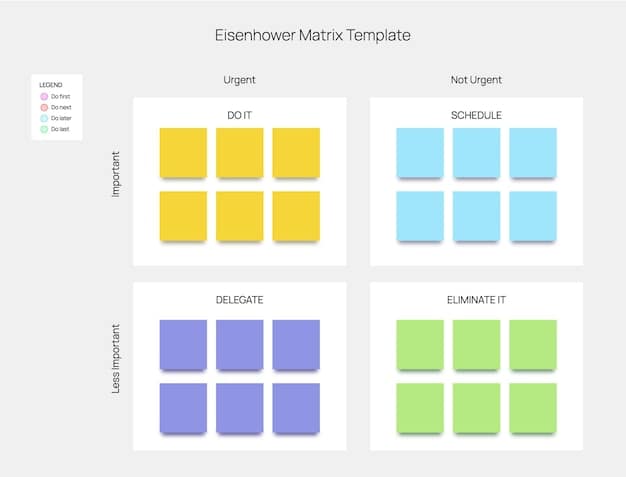Master Time-Sensitive Tasks: Prioritize & Conquer Your Schedule

Time-sensitive tasks demand immediate attention to prevent disruptions; prioritizing them effectively requires evaluating urgency, using tools like Eisenhower Matrix, allocating specific time blocks, and maintaining flexibility to avoid derailing your overall schedule.
Navigating a workday often feels like juggling multiple balls, but when time-sensitive tasks enter the fray, the stakes rise. Mastering prioritization is crucial to manage these urgent matters without letting them disrupt your carefully planned schedule, making you feel overwhelmed and unproductive.
Understanding Time-Sensitive Tasks
Time-sensitive tasks are those that require immediate attention. These tasks often have deadlines or consequences associated with them if not addressed promptly. Recognizing the difference between urgent and important tasks is crucial for effective prioritization and ensuring you don’t get bogged down in less critical activities.
Defining Urgency and Importance
Urgency refers to tasks that demand immediate attention, often due to deadlines or potential negative consequences. Importance pertains to tasks that contribute to long-term goals and overall success. Understanding this distinction is the foundation of effective time management.
Common Examples of Time-Sensitive Tasks
Examples include responding to urgent emails or customer requests, addressing critical system failures, or preparing for an imminent presentation. These tasks typically disrupt planned schedules and require immediate action.
- Responding to critical customer inquiries.
- Addressing a sudden system outage.
- Completing a report with an impending deadline.
By differentiating between urgent and important tasks, you can develop a more strategic approach to managing your workload effectively.
Prioritization Techniques for Urgent Matters
Effective prioritization is the key to managing time-sensitive tasks without derailing your entire schedule. Employing structured methodologies like the Eisenhower Matrix and other strategies can help you make informed decisions about what deserves your immediate attention and what can wait.
The Eisenhower Matrix
The Eisenhower Matrix categorizes tasks based on urgency and importance: Urgent/Important (Do First), Not Urgent/Important (Schedule), Urgent/Not Important (Delegate), and Not Urgent/Not Important (Eliminate). This helps streamline decision-making and avoid getting caught up in trivial matters.
Other Prioritization Methods
Aside from the Eisenhower Matrix, the Pareto Principle (80/20 rule) suggests focusing on the 20% of tasks that yield 80% of the results. Time blocking and task batching further enhance efficiency by allocating specific time slots and grouping similar activities.

- Utilize the Pareto Principle to identify high-impact tasks.
- Implement time blocking for focused work periods.
- Batch similar tasks together to reduce context switching.
Prioritization techniques enable you to make informed decisions about your workload and address urgent matters without losing sight of long-term objectives, resulting in increased productivity and reduced stress.
Strategies for Integrating Urgent Tasks Into Your Schedule
Even with the best planning, unexpected urgent tasks can arise. Having strategies in place to integrate these tasks into your schedule without causing chaos is essential for maintaining both productivity and peace of mind.
Assessing the Impact of New Tasks
Evaluate how a new, urgent task will affect ongoing projects. Consider what can be postponed or delegated to accommodate the new priority. Sometimes, re-evaluating deadlines or negotiating extensions can free up necessary time.
Flexible Scheduling Techniques
Creating buffer times between scheduled tasks or using digital tools for rescheduling can accommodate unexpected demands. Being ready to adjust your daily or weekly plan helps maintain momentum despite unforeseen urgencies.
- Build buffer times into your schedule.
- Utilize rescheduling features in digital calendars.
- Negotiate deadlines when necessary.
By preparing flexible strategies, you adapt swiftly to incoming time-sensitive tasks, thereby improving overall time management rather than suffering disruptions.
Communicating and Delegating Effectively
Effective communication and delegation are vital components of handling time-sensitive tasks. Knowing how to convey urgency, clearly define responsibilities, and entrust tasks to others can drastically reduce personal workload and ensure critical items are addressed efficiently.
Importance of Clear Communication
Clarity in communication ensures that the task’s urgency and expectations are well-understood. Over-communication is preferable to leaving room for misinterpretation, and confirming understanding can prevent costly errors.
Delegation Best Practices
Delegate tasks to competent team members, provide necessary resources, and offer support when needed. Empowering others not only distributes workload but also fosters professional development and enhances overall team efficiency.

- Clearly define task expectations.
- Provide necessary resources and support.
- Follow up to ensure successful completion.
Communicating and delegating effectively transforms handling time-sensitive tasks from a siloed individual effort into a synchronized team accomplishment, leading to optimized performance and a more balanced workload.
Tools and Technologies to Enhance Prioritization
Leveraging the right tools and technologies can significantly enhance your ability to prioritize and manage time-sensitive tasks. From digital task managers to specialized software, these resources provide structure, automation, and insights to boost efficiency.
Digital Task Management Systems
Utilize platforms like Asana, Trello, or Todoist to manage tasks efficiently. These tools offer features such as task assignment, deadline tracking, and priority setting to help streamline workflow.
Calendar and Scheduling Applications
Employ calendar apps like Google Calendar or Microsoft Outlook to schedule tasks, set reminders, and block out time for specific activities. Integrating scheduling apps with task managers provides a holistic approach for managing time.
- Explore integration capabilities between chosen tools.
- Customize settings to match your workflow preferences.
- Utilize reminder functions to keep tasks on track.
By incorporating the right tools, you can streamline your workflow, boost productivity, and stay on top of time-sensitive tasks without feeling overwhelmed. Each person ultimately tailors the chosen platform to meet their unique needs.
Preventing Future Time-Sensitive Crunches
While handling current time-sensitive tasks effectively is important, preventing future crunches is equally crucial. By proactively planning, maintaining open communication, and continually assessing your workflow, you can mitigate the frequency and impact of urgent demands.
Proactive Planning and Preventative Measures
Anticipate potential issues and plan contingencies to avoid unexpected escalations. Setting up preventative maintenance schedules and proactively addressing known vulnerabilities reduces the likelihood of urgent problems arising.
Continuous Workflow Assessment
Regularly assess workflow processes to identify bottlenecks and areas for improvement. Adjust strategies based on performance metrics to optimize resource allocation and prevent future fire drills.
- Schedule regular workflow reviews with your team.
- Seek feedback from colleagues to identify blind spots.
- Implement iterative improvements based on insights gained.
Preventing future time-sensitive crunches involves proactive planning, continuous assessment, and adaptive strategies, resulting in a smoother, more predictable workload and increased overall efficiency and morale.
| Key Point | Brief Description |
|---|---|
| ⏰ Prioritize Tasks | Use methods like Eisenhower Matrix to sort urgent vs. important tasks. |
| 🗓️ Scheduling | Incorporate flexible scheduling techniques to manage disruptions. |
| 🗣️ Communication | Communicate clearly and delegate tasks effectively. |
| 🛠️ Use Tools | Use digital tools to enhance prioritization and task management. |
Frequently Asked Questions
▼
Assess if the task has a strict deadline or immediate consequence if not addressed. Determine if delaying it impacts other tasks or stakeholders negatively. If the answer is yes, it’s time-sensitive.
▼
It’s a prioritization tool sorting tasks by urgency and importance. Urgent/Important tasks are handled immediately, Important but Not Urgent tasks are scheduled, Urgent/Not Important tasks are delegated, and Not Urgent/Not Important tasks are eliminated.
▼
Start with clear communication: explain the task, timeline, and expected outcome. Empower team members with resources, and check in periodically to provide support and ensure progress alignment.
▼
Asana, Trello, and Todoist are excellent for task management and prioritization. Google Calendar and Microsoft Outlook help with scheduling and reminders to keep crucial tasks top of mind.
▼
Proactive planning and establishing preventative measures. Regular workflow reviews help in identifying bottlenecks and improving future processes, thereby limiting future emergencies through preemptive action.
Conclusion
Effectively managing time-sensitive tasks hinges on clear prioritization, flexible scheduling, and smart resource use. By mastering these skills and leveraging the right tools, you can maintain control of your schedule and minimize disruptions, promoting a productivity-driven and less stressful environment.





